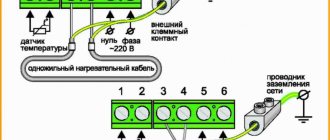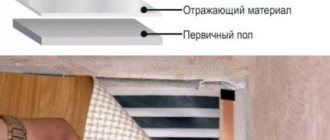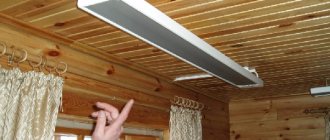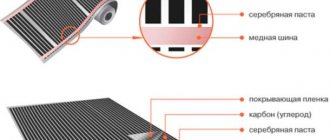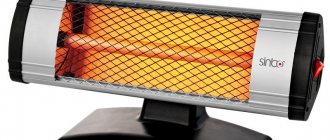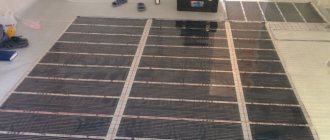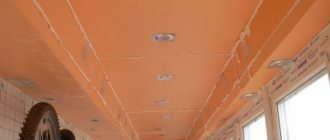Is it harmful to health: main myths
Any professional can quickly and clearly explain the principle of operation of a heated floor, regardless of its type, but most homeowners do not have sufficient knowledge in this area, so we can roughly divide the myths about the dangers of a heating element into several points:
Dangerous infrared radiation
First of all, this concerns electric infrared heated floors, which use a special film that heats the surface by acting on electromagnetic waves. Due to lack of information, many believe that these rays are harmful to living organisms, but this is far from true. Of course, exposure to ultraviolet radiation or high-power magnetic radiation is dangerous to human health, but in underfloor heating systems this figure is much lower than that of any other household appliance, even a cell phone. Therefore, electromagnetic waves emitted by film heating are absolutely harmless to the body and surrounding objects.
Raises dust and is harmful to allergy sufferers
This myth has no basis, since the heating element inside the screed transfers its temperature to the floor covering in the form of linoleum, ceramic tiles or laminate, and does not use air as heat convection, as heating radiators do. A warm floor does not produce, much less spread, harmful dust indoors; air masses do not come into contact with it, but interact with the main, finishing coating, so if you keep it clean, no problems will arise.
Dries the air
As in the previous paragraph, it should be noted that there is no direct contact with air in such a system; the floor surface heats up and transfers heat to surrounding objects, furniture and walls. Yes, the air also warms up and evaporates moisture, but its circulation is much slower than that of convection radiators. This problem can be solved by adding devices for generating steam and air humidification to the room.
Creates blood flow from head to feet
This myth arises from the opinion that the warmer a person’s limb is, the more blood flows to it, yes this is true, and this is reliable information, but such problems arise only when a certain temperature is reached, which should be at least 45-60 degrees. In underfloor heating systems, the maximum coolant temperature is 45 degrees, and the finishing surface when fully heated is no more than 25-30 degrees, which is very comfortable for both children and adults.
It's not comfortable to sleep on the bed
This is the only myth that is truly justified. When a person is awake, the comfortable temperature of the heated floor and indoors is 25-28 degrees, and during sleep no more than 18 degrees. Therefore, when heating a bedroom with warm floors, many people wonder about comfort. This problem can be easily eliminated by installing a thermostatic regulator on the water system manifold or an electrical supply thermostat on the heating element of the mat. Before going to bed, the owner simply sets the required temperature in the bedroom on the regulator, and the set parameter will be automatically maintained throughout the night.
Evaporation from flooring
Regardless of the type of floor finishing, be it ceramics, linoleum or laminate, high temperatures are required to release vapors and gases from these materials; only under this condition will the coating heat up excessively and release harmful substances. The heated floor is designed to operate within acceptable parameters from 0 to 45 degrees, which is a comfortable temperature for humans and is not sufficient for the material to overheat and cause an unpleasant odor.
Thus, all of the listed myths about the dangers of heated floors are greatly exaggerated and far-fetched; they can easily be refuted by studying all the physical and chemical properties of the floor covering, as well as the technical indicators of a properly installed system.
Harm of IR heated floors – myths and reality
The most common myths and facts regarding how harmful infrared heaters are, and underfloor heating of this design in particular:
- myth one: IR heated floors have a negative effect on human health - an infrared heater cannot cause significant harm to human health. Such equipment produces radiation with a wavelength from 2-3 microns to 10 microns. Infrared radiation with a wavelength of 9.6 microns is typical for humans. Based on the data obtained, they come to the conclusion that IR heaters with short-term exposure do not affect metabolism and other processes in the body. However, the situation changes with intensive use of such a “warm floor”. That is why it is recommended as an additional source of heat;
- myth two: IR underfloor heating system leads to overheating of the extremities. All devices are developed in accordance with safety standards, and therefore cannot lead to any burns or overheating;
- myth three: the disadvantages of IR devices are drying out the air. The radiation from the device does not change the physical parameters of the air, including its humidity;
- myth four: this system can cause burns to human skin. If the intensity of IR radiation is high, it will lead to dryness of human skin. However, this was not observed in practice.
Related article: Using color to paint walls
A warm floor based on an infrared emitter, when used correctly, will create a pleasant microclimate in the room for all family members. Information about the dangers of infrared heaters is often false.
Does it damage furniture, electronics and plumbing fixtures?
An important condition is the layout and location of the heated floor system over the entire area of the heated room; here, an unqualified specialist may have problems. Many people believe that heated floors are harmful to household appliances and furniture elements. As a rule, most household appliances, such as a TV, kitchen utensils and others, are located at a considerable distance from the floor, so they do not have any contact with the heating system, the only exceptions being the refrigerator and washing machine, which are installed directly on the finishing coating.
To prevent the body of these items from heating up, it is necessary to position the underfloor heating coil in such a way that heating does not occur under the devices. In addition, with such a layout, you can save on building materials, because it is not advisable to heat floors in an area where a person does not come into contact with the surface.
Plumbing elements, such as sanitaryware, a bathtub or a sink with a pedestal, are not afraid of the effects of temperature, so they can be safely installed on a surface with a heated floor, but you should monitor the weight of the item, since parts with excess weight can push through the floors and compromise the integrity heating element.
The dangers of overheating your feet
Another argument in favor of the fact that heated floors are harmful to health is overheating of the feet, which leads to the outflow of blood from the brain to the legs. And this, in turn, becomes the cause of exacerbation of cancer, varicose veins and something else. Doctors say this in all seriousness.
The floor temperature should be 29 degrees.
In principle, these arguments make sense, but they have nothing to do with reality. Let's start with the fact that if the heated floor is working properly, the temperature on the surface should be no more than 29 degrees - this is a fact. That is, if everything is calculated and installed correctly, there cannot be any overheating of the feet.
A popular proverb says: “Keep your feet warm, your head cold, and your belly hungry.” It’s somehow absurd to argue with age-old folk wisdom. Based on it, it turns out that heated floors are not harmful, but rather useful. But the lack of heating can have serious consequences. For example, you live on the first floor, the floor is simply icy, and you have children. It is impossible to constantly monitor a child so that he does not sit on a cold tile. As a result, the child gets sick, sometimes this leads to complications or even becomes chronic. There are disproportionately more advantages from heated floors than disadvantages, especially such far-fetched ones.
Is it harmful to the car?
A warm floor in an individual garage is justified only in cases where the room itself consists of a permanent structure and is well insulated. This room is not an environment where people are constantly present, so maintaining a minimum temperature of 15-17 degrees is quite sufficient. This system does not cause any harm to the items stored in the garage and the car; on the contrary, the car is constantly in a dry environment, which prevents the occurrence of corrosion and rust. If you need to increase the temperature inside the garage, you can combine heated floors with converter radiators or a heat gun.
Warm floors dry out the air
Again, if you install the heated floor correctly, the temperature of the hot coolant will not exceed 45 degrees, and the temperature of the floor surface will not exceed 28 degrees. With such characteristics, you are not in danger of drying out the air.
So we have looked at the main points that relate to the harm of heated floors. As you understand, some of them are classified as myths, while others are due to incorrect installation technology.
Warm floors are the most economical heating system today and it is worth thinking about installing them if you want to ensure warmth and comfort in your home for the next 50 years.
Don’t forget to share the truth about the dangers of heated floors with your friends on social networks (to do this, you can click on the buttons below). Let's do a common good deed in conveying the correct information.
When there might be problems
The only condition when problems with heated floors may arise is the wrong choice of system and its installation with errors. When choosing a particular type of heating device, for example an electric heating mat or a pipe system with coolant, it is necessary to strictly follow the technical regulations and take into account the parameters of the room.
There are several types of mistakes that installers make during the installation of heated floors, these include:
- When installing a water floor, if you place the collector below the main line, the system will constantly be filled with air, as it tends to the highest point. This factor can completely clog the pipe, which will disrupt the circulation of the coolant. To avoid such consequences, it is necessary to place the collector in the highest position and equip it with automatic air release.
- The most common mistake in cable underfloor heating is damage to the outer winding of the heating element or a fracture of the core in an unnatural position. Also, the burnout of the harness is caused by the supply of current with a high voltage that does not correspond to the rating of the thermostat. For uninterrupted operation, it is necessary to equip the electric floor heating system with a voltage stabilizer, which will prevent current surges by equalizing it.
- Film heated floors with infrared radiation are most vulnerable at a break, for example when pouring it into a screed, when the copper conductors are under pressure from the mixture; bending or deformation of even one thread will lead to loss of contact and complete failure of the system. To prevent this breakdown, it is necessary to carefully select the building mixture for floor screed, preferably it is a powder with a fine fraction.
Comparative analysis of IR and cable underfloor heating
Cable and infrared heated floors have become widespread as an additional source of heat. But which one is better and which one to choose - these are the questions asked by those who have not decided on the nature and type of floor heating system. To do this, you need to analyze the pros and cons of both designs.
Which floor is better? Comparative analysis of cable and infrared systems:
- type of energy consumed - in both cases it is electric current. However, IR heaters are 50% more economical than a cable circuit;
- power – IR heating elements with the same energy consumption are 2 times more powerful compared to cable analogues;
- safety – both systems are characterized by increased operational safety;
- durability – the guaranteed service life of both systems is 20 years. However, infrared flooring has disadvantages. A non-original product quickly fails because its conductors lose integrity;
- uniform heating - the cable circuit warms the room due to air convection. As a result, a significant temperature difference forms in the room. It is lower near the floor, higher at the ceiling. Infrared radiation raises the temperature of surrounding objects. Regardless of whether it is a piece of furniture, a ceiling or a floor covering, it will all be equally warm. Consequently, the last version of the heated floor warms the room more evenly, and therefore it is better;
- ease of installation - film floors based on infrared radiation are equally easy to install on vertical, horizontal and inclined surfaces, which cannot be said about the cable analogue. Its disadvantages are difficulty in installation. Cable heated floors can only be laid under ceramic tiles. IR heated floors do not have such disadvantages. It fits equally well under any floor covering. While functioning, it does not harm linoleum, laminate, parquet, and other decorative floor finishing materials.
Related article: Grounding cast iron, acrylic and hot tubs
If we consider both technologies in combination and, based on the data obtained, choose which gender is better, then there is no clear answer to this question. Each option has both advantages and disadvantages. The choice is made based on the personal preferences of the owner of the house or apartment and the subsequent operating conditions of the system.
The best posts
- DIY crib organizer: manufacturing technology
- Where to start building a house on a site - all stages, from foundation to roof
- What glue is best for gluing ceiling tiles?
- DIY New Year's socks for gifts with photos and videos
- Interior finds: decorative shelves and embroidered tablecloths
- Three-thread: types (with fleece, fleece), description and composition of fabric
- Openwork rose from beads: master class with diagrams and video
- How to paint doors yourself
Features and myths
Some people want to improve the comfort of their apartment or house, but they are stopped by the fear of serious problems. Meanwhile, most of the negativity about electric heated floors is caused by ignorance or the use of low-quality products, and in fact is a myth. Here are the most popular ones.
- Warm floors increase the amount of dust. In fact, the thermal energy of the heating system almost does not lift air from the floor and from other places. That is, the dust does not become more or less, and if you have allergies, you need to continue to clean it regularly (as without heated floors).
- The indoor air is always too dry. To prevent this from happening, you need to correctly select the power of the heating system, carry out installation in compliance with technology, and then set the regulator to a moderate temperature. Then you won't need a humidifier.
- It is harmful to walk barefoot on a heated surface. This is an obvious myth: just remember the numerous walks barefoot on hot or warm sand. Children and adults love to walk barefoot on warm surfaces, and doctors have not found any pathologies associated with this.
- Furniture cannot be placed on heated floors. This is only partly true: heavy objects really cannot be placed on top. But this can be taken into account at the installation stage. And if you need freedom of choice, install a heated floor with self-regulation, which is protected from overheating.
- Harmful electromagnetic fields. On the one hand, any type of underfloor heating (heating cable, thin mat, infrared film and rods) consumes electricity and creates electromagnetic radiation, like any electrical device. But this radiation meets modern standards and is significantly lower than the maximum standards: for example, for a single-core cable - 50 times, and for a two-core cable - 300 times.
- Due to the heating of the finish coating, toxic substances that are hazardous to health are released. In fact, this is not true: even if you place the heaters under tiles or laminate, no dangerous connections will appear. Even low-quality flooring melts or smolders only at high temperatures - from 70⁰C. But the floor usually warms up to 25-27 degrees, which is much lower and quite safe.
IR floors emit infrared radiation that is harmful to health
Opponents of the use of IR film in heating argue that infrared radiation in many cases causes significant harm. The film promotes the emergence and development of malignant tumors, provokes blood diseases, and also slows down the healing of purulent wounds.
Firstly, only broad-spectrum thermal radiation can have such an effect on health, which cannot be the case if heating is carried out using cable, carbon or infrared radiation. Typically, an IR heating film element is always located dispersed across the entire area of the room and emits long waves that are not dangerous to the human body. Thus, the specific intensity of electromagnetic radiation per unit surface of a heated floor is much less than dangerous values.
Secondly, in this case, IR radiation is significantly attenuated by the decoupling layer, which is formed by the heat-insulating film and the floor covering itself. Theoretically, harm to the body can be caused if, for example, an area of a person’s skin or eye is located near an unshielded radiation source for a long period of time. This is not possible when the infrared floor is in constant use.
The infrared thermal spectrum of electromagnetic waves is widely used in medicine in the treatment of many diseases. Waves of the same length - from 8 microns and more - are also used in IR systems, thanks to which infrared heated floors function. Thus, such a warm floor is not only not dangerous, but also has a beneficial effect on the human body. Film IR emitters:
- increase immunity to various kinds of infectious diseases;
- clean the indoor air from pathogenic microbes;
- normalize blood pressure due to the favorable distribution of the resulting heat flows.
Is the system harmful?
If you study the question of whether electric heated floors are harmful to human health, you can find defects in such heating systems. For example, a cable floor can emit electromagnetic waves, but tests have shown that they are no stronger than, say, a microwave or TV. It is unlikely that a person surrounded by numerous electrical appliances and mobile phones will feel this radiation at all.
Another question is how effective warm floors are as the main source of heat, but this is a completely solvable problem. It is enough to insulate the room so that electric floors not only heat well, but also become economical.
Doctors rarely indicate unequivocally that any influences of the modern world are harmful. We need statistics, expensive research... Regarding heated floors, there are also no exact conclusions from the Academy of Sciences... But “alarming rumors” and “suspicious speculation” did not arise out of nowhere. Let’s figure out what is known exactly in fact about this matter, and also consider the generalized opinion of experts about the harmfulness of heated floors, and the typical actions of typical “conscientious” installers, under the slogan “do no harm.”
Tell me doctor...
Any therapist, or at least every second sober person, will say that if you constantly keep your feet in a basin with warm water, then something unhealthy will definitely happen to them - “the veins will swell, the joints will swell.” You can go to the nearest clinic and ask the doctor on duty about this.
It has been pointed out more than once that unnatural heating of the lower extremities leads to increased blood flow and vascular diseases.
It remains to be seen what “unnatural” is and what temperature of the heated floor will be dangerous and what will be acceptable.
From the available information, we only know that if the floor temperature is +28 or higher, it will seem warm, since this is the surface temperature of human skin. And, by the way, being in such an environment for a long time people begin to experience discomfort.
Hence the unequivocal conclusions of experts - keep the temperature of the heated floor covering at a comfortable temperature, usually in the region of +18 - +24 degrees. The coating should feel “cool”, then it will suit everyone, and there have been no complaints about it yet...
The floor can be electric
An electric heated floor has electromagnetic radiation. This radiation has not yet been called useful. With an increased background of eggs, chickens do not hatch, etc.
They say that the field strength from such systems is not high, but this is not true. The fields are summed up, from sockets, floors, wires outside the window, refrigerator...
This cannot be arranged in a nursery; there should be no children on a surface emitting a high electromagnetic background.
Particular danger of heated floors
Very little is said about the real danger that underfloor heating poses, so it’s worth mentioning here.
As a rule, we do not have separate ventilation in our rooms. For the winter, windows can be sealed shut.
With a radiator heating system, a powerful convection air flow occurs. It also entails the movement and mixing of air through the doorway, so that quite intense air exchange occurs between the rooms. And thus, even a sealed room is ventilated at the expense of its neighbors.
With only one heated floor there is no convection. There is no air movement. In a room without ventilation devices, without gaps in external structures, there will be practically no air exchange.
If there is no walking through the doorway, air stratification may occur - carbon dioxide is heavier, it will begin to accumulate near the floor, and so-called “dead air” will arise. If there is a release of carbon dioxide or other harmful gases in the room itself, then this is already very dangerous...
Warm floors are harmful if used incorrectly and unskilledly installed.
It is believed that such heating is available for installation by almost everyone. However, this is not true: only a qualified specialist can correctly install and launch the “warm floor” system, otherwise, defects and installation errors result in significant financial costs. However, the system of such heating itself is considered to be thought out to the smallest detail.
However, there are situations where improperly installed heating subsequently causes significant harm to homeowners:
- The finishing coating is a material whose performance characteristics do not require constant heating. For example, parquet dries out when in constant contact with a heated surface. This not only reduces the durability of the coating, but also reduces the relative humidity in the room. This negatively affects the health of children, allergy sufferers and asthmatics, since their body requires an optimal level of humidity;
- During installation, we decided to “save” on thermostats. The result is that a lot of fine dust is formed in dry air, which can also cause great harm, especially to people predisposed to allergies;
- If the ventilation is not properly arranged, the underfloor heating system provokes the formation of fungi and mold, and also causes windows to fog up. In this case, thermal radiation brings undoubted harm, since it is fraught with possible skin diseases and damage to household property.
If we sum up all the pros and cons, the conclusion will be clear: the underfloor heating system does not pose a threat to the human body. The main thing is to strictly adhere to the manufacturer’s recommendations, and then heating your home will be efficient, safe and reliable.



